The Corsair H150i Elite Capellix AIO Cooler Review: Go Big Or Go Home
by E. Fylladitakis on October 15, 2020 9:30 AM EST- Posted in
- Cases/Cooling/PSUs
- Corsair
- Water Cooling
- Liquid Cooling
- RGB
- iCUE
Testing Results, Maximum Fan Speed
As always, we'll start things off by testing things at full speed/performance. Our maximum speed testing is performed with both the fans and the pump powered via a 12V DC source. This input voltage should have the pump and fans matching the speed ratings of the manufacturer. According to Corsair’s specifications, the MagLev fans included with the H150i Elite Capellix should have a rotational speed of 2400 RPM. Our tachometer indicated that the fans were rotating at an average speed of 2370 RPM, very close to their rated specifications.
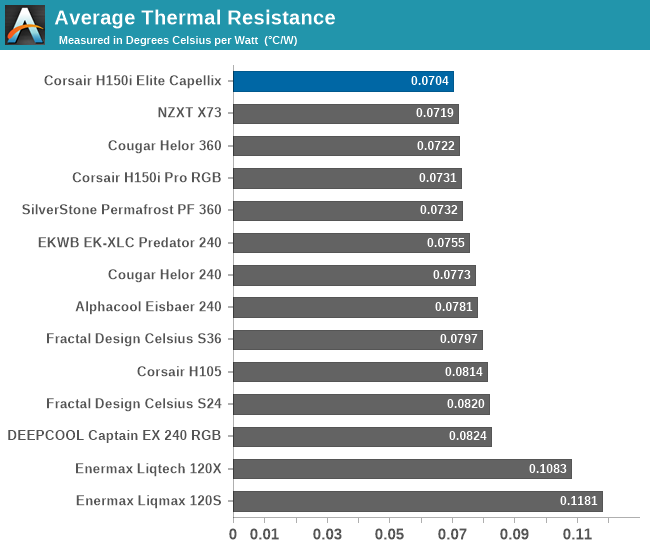

| Core Temperature, Constant Thermal Load (Max Fan Speed) |
The Corsair H150i Elite Capellix seems to be getting the best thermal performance out of every similarly sized AIO cooler that we have tested to this date, outperforming NZXT’s X73 by a whisker. The performance seems to be fairly stable across most of the load range, offering predictable performance regarding of the load, with the exception of very low loads where the temperature difference is far too small for appropriate heat transfer between the mediums.
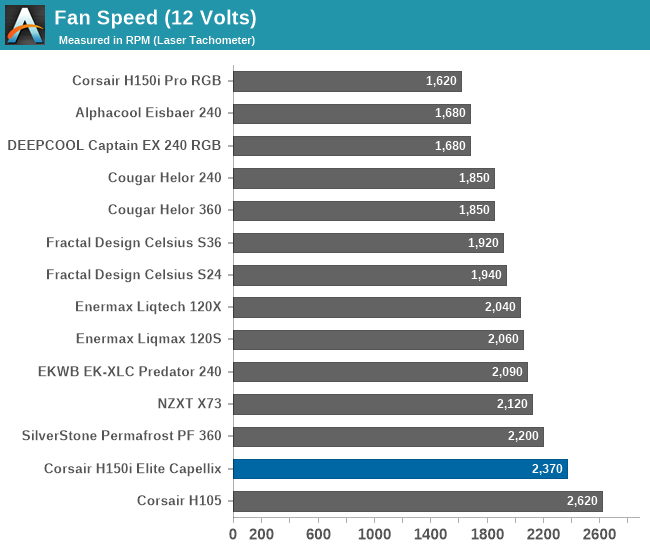
The average thermal resistance of 0.0704 °C/W is impressive but users need to keep in mind that this performance comes with the fans rotating at their maximum speed. With the powerful fans of the H150i Elite Capellix, this results to a sound pressure level of 43 dB(A), a relatively high figure for a CPU cooler.
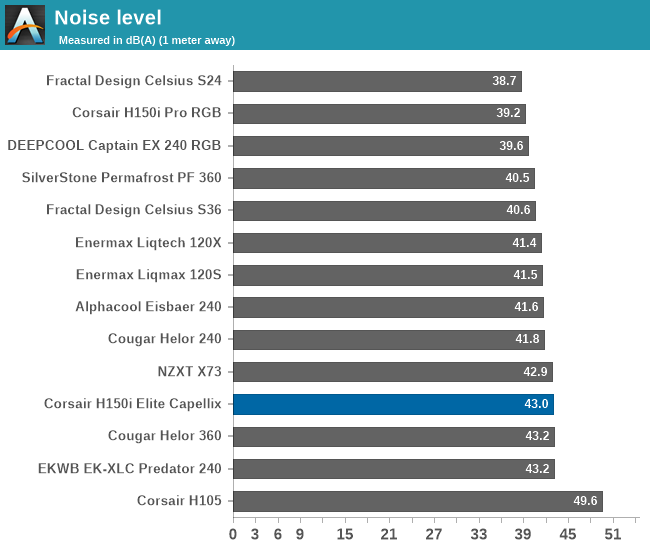
Testing Results, Low Fan Speed
Using a PWM voltage regulator, we reduced the speed of the fans manually down to half their rated speed. At this setting, the 120 mm MagLev fans of the H150i Elite Capellix rotate at 1220 RPM. Since the pump’s speed cannot be controlled directly, we had the Commander CORE module attached to a PC and set the pump to operate in its “Quiet” mode while testing.
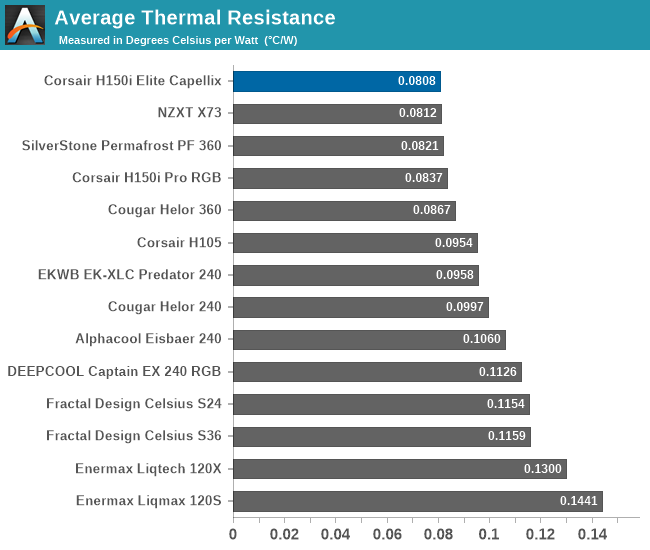
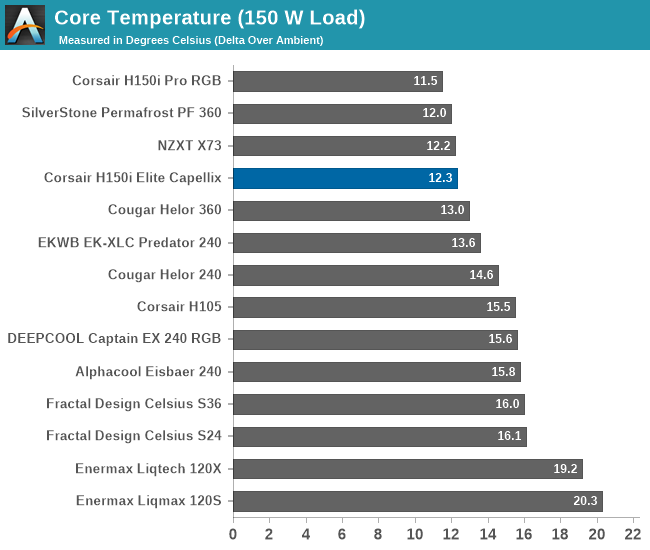
| Core Temperature, Constant Thermal Load (Low Fan Speed) |
When it comes to thermal resistance, Corsair’s latest AIO cooler initially seems to be slightly outperforming all of the 360 mm coolers that we have tested to this date. The average thermal resistance of 0.0808 °C/W is almost identical to the figures we received from the recently released NZXT X73, with Corsair’s MagLev fans giving the H150i Elite Capellix a small advantage in terms of acoustics.
But if one looks at just the thermal performance charts, other implementations with significantly slower fans, including Corsair’s older H150i Pro RGB, initially seem to be performing slightly worse. A closer look reveals that the better thermal performance is due to the quick fans of the H150i Elite Capellix, resulting to significantly higher noise levels. Setting the fans to operate even slower is likely to neutralize any thermal performance advantage that the cooler has.
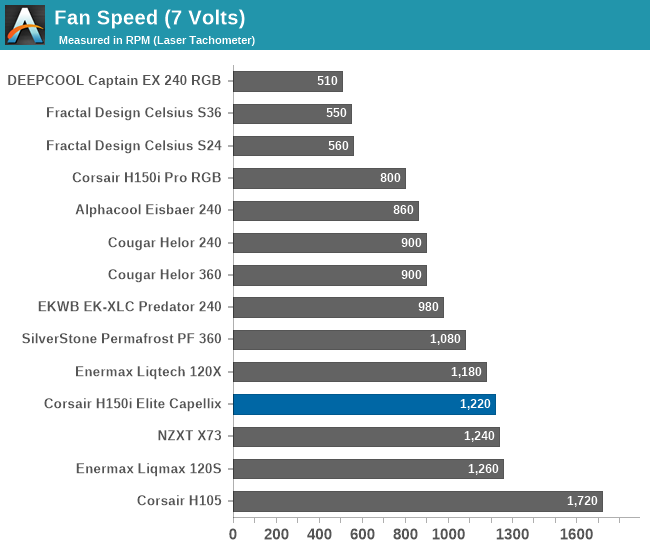
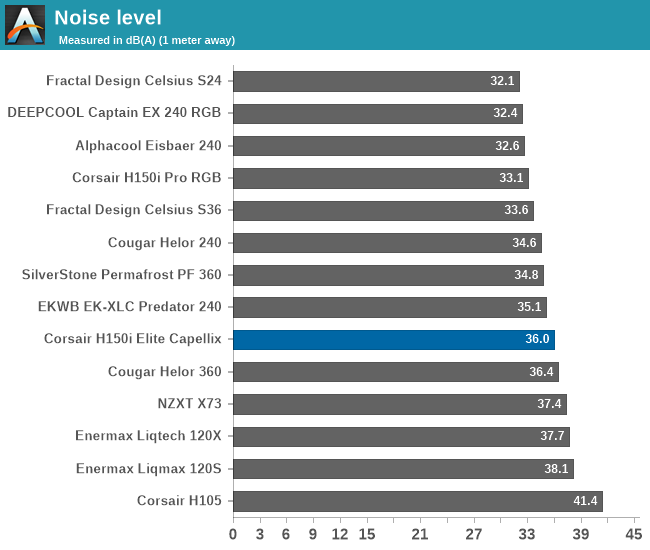
Thermal Resistance VS Sound Pressure Level
During our thermal resistance vs. sound pressure level test, we maintain a steady 100W thermal load and assess the overall performance of the coolers by taking multiple temperature and sound pressure level readings within the operating range of the stock cooling fans. The result is a graph that depicts the absolute thermal resistance of the cooler in comparison to the noise generated. For both the sound pressure level and absolute thermal resistance readings, lower figures are better.
This graph reveals interesting information regarding the overall performance of the H150i Elite Capellix. Although it does manage to get the best thermal performance out of every other similarly sized cooler, it can be seen that the older H150i Pro RGB actually outperforms it when taking the acoustics into account. This is because of the fast 2400 RPM fans that Corsair includes with the H150i Elite Capellix and our two-point testing methodology. Theoretically, the H150i Elite Capellix would perform identically or nearly identically with the H150i Pro RGB if both coolers were to share the same fans. It is also proof that the long and thin 360 mm radiator benefits very little from higher airflow, as its heat transfer surface is far too large to allow for significant temperature differences even if the airflow is low.


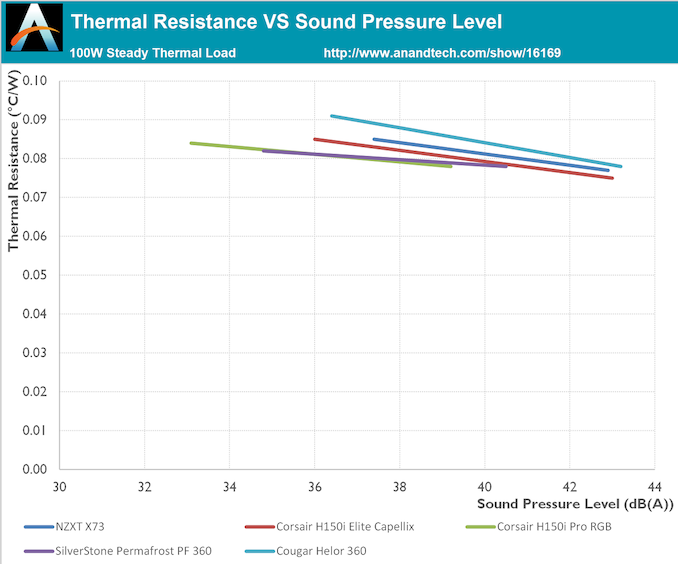








37 Comments
View All Comments
hehatemeXX - Thursday, October 15, 2020 - link
So new fans.. I wonder if we replaced these fans across the board if they are all the same?Makaveli - Thursday, October 15, 2020 - link
Looks good but those fans and that controller add alot of wires and abit of a mess compared to earlier version of this product that come with non LED fans but progress I guess.DanNeely - Thursday, October 15, 2020 - link
If you can crank the brightness of the frag harder disco lights up high enough I guess the cable management debacle the bring can be hidden in the shadows.Makaveli - Thursday, October 15, 2020 - link
lol so blind yourself so you can't see the wires got it :)eek2121 - Thursday, October 15, 2020 - link
That was always the issue with the corsair stuff. We are long overdue for an overhaul of connectivity standards. 3-pin/4-pin fan connectors should be replaced with a 6-pin connector of the same time and the minimum power spec provided by the motherboard should be raised to 12V @ 1.5 amps.Tomatotech - Friday, October 16, 2020 - link
Install a Bluetooth / WiFi fan control? Low power Bluetooth probably better here, and would eliminate a few control wires. WiFi would let you monitor your pc thermals remotely from your phone while doing a long job (without needing to learn how to do a remote login from phone). Even a proprietary radio (like Logitech’s mouse / keyboard dongle) would be mostly fine if a bit annoying.YB1064 - Thursday, October 15, 2020 - link
A few LEDs distinguish this from the competition. Can't do much more with AIO I suppose.eek2121 - Thursday, October 15, 2020 - link
There is nothing wrong with a quality AIO. My NZXT 280mm is whisper quiet and keeps my 3900X in the 60s (70s when video encoding or rendering) The only noise I hear coming from the PC is the GPU.Beaver M. - Friday, October 16, 2020 - link
I highly doubt that yours is whisper quiet. Everyone ever who claimed that to me was proven wrong when I listed to it myself. The pump always adds a very annoying noise.My air cooled PC is really silent. The loudest part is my external 2.5" HDD, which I always turn off when I dont need it, because, even if its quiet for guys like you, its extremely annoying with a silent PC like mine.
But I get that a lot of people think loud components are quiet, because they have bad hearing and additionally wear headsets on their PC, which probably is the cause of bad hearing anyway.
29a - Friday, October 16, 2020 - link
"My air cooled PC is really silent."I highly doubt that yours is really silent. Everyone ever who claimed that to me was proven wrong when I listed to it myself.